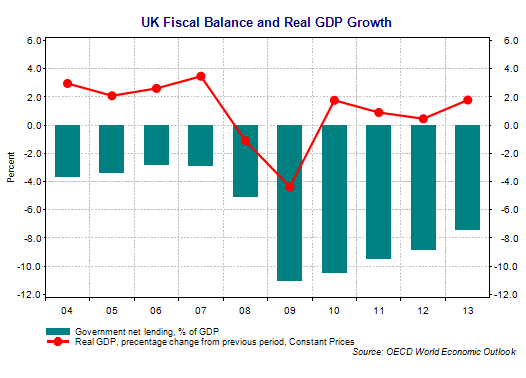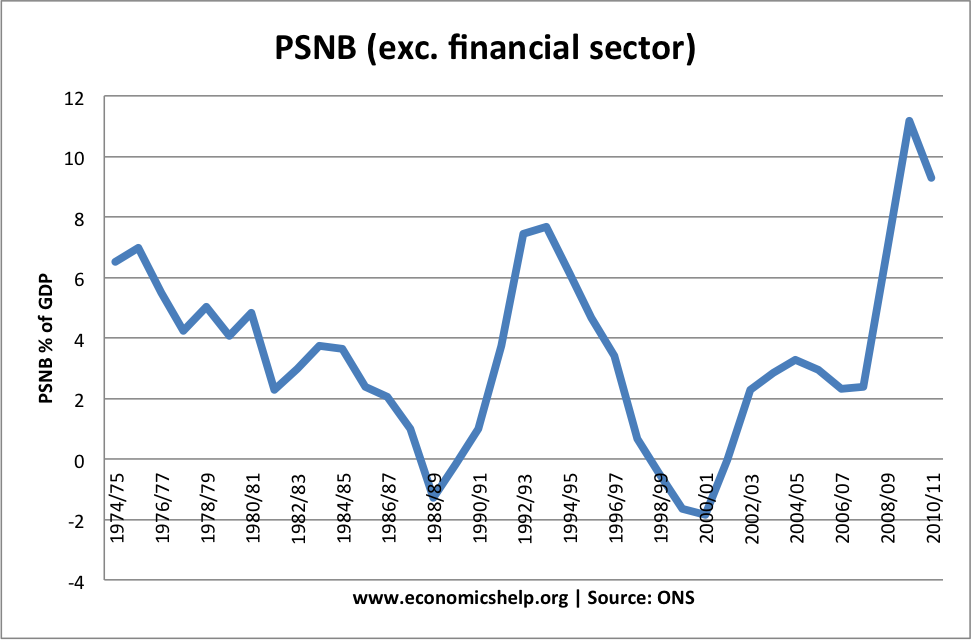Deficits and the National Debt Economics Online Tutor
Post on: 5 Апрель, 2015 No Comment

Many people are confused about the difference between a deficit and a debt.
A deficit refers to an excess of expenditures over revenue during a specific time period. The national
deficit usually refers to the amount by which government spending is in excess of tax revenue in a given
year. This is a flow concept. It involves activity over a period of time.
A debt refers to the balance of all funds owed from prior commitments. The national debt refers to the
balance of all payments owed due to previous deficit spending. The national debt is the total amount of
government bonds outstanding. Essentially, it is a running total of previous deficits, less payments made
on prior debts. This is a stock concept. It involves a balance at a specific point in time.
Both national deficits and national debts are created by borrowing instead of using tax revenue to pay
for government expenditures. Governments borrow money by issuing government bonds to the public.
These government bonds represent financial investments to the purchasers, but they represent an
obligation to repay for the government that issues the bonds.
One measure of the national debt is it percentage of GDP. This measure serves as a reference point. It
will put the debt into perspective as to the size of the economy.
Consequences of Deficits and the National Debt
Crowding out:
It is not entirely clear that crowding out occurs, so differences of opinions exist among economists from
different schools of thought.
When governments run a deficit, they finance spending by borrowing. This involves selling bonds on the
open market. When the government sells bonds, it increases the supply of bonds, decreasing the market
price of all bonds on the market. It can influence the market prices because the government’s
transactions are often a large percentage of the activity in the bond market, giving the government
market power. When bond prices decrease, their yields increase, raising the interest rates for bonds. If
this in turn causes other interest rates in the economy to increase, then the cost of borrowing will
increase for firms planning private investment. If firms decrease investment because of higher interest
rates caused by government deficits (the federal deficit), then private investment is crowded out. This
will decrease real GDP both in the present time period and in the future.
Trade deficits:
Some economists believe that budget deficits lead to trade deficits. If budget deficits do indeed raise
real interest rates (and cause crowding out), then domestic securities will be more attractive to foreign
investors. If foreign investors buy more domestic securities as a result, this will increase demand for the
domestic currency. The domestic currency will appreciate in value due to an increase in demand. This
changes the exchange rates for currencies, making foreign-made goods cheaper for domestic consumers
and domestic-made goods more expensive for foreign consumers. As a result, net exports will decrease,
which will also decrease real GDP.
Interest payments as a portion of future government budgets:
The national debt requires the government to make interest payments in the future. These interest
payments represent money that the government cannot use for something else, including tax relief.
To the extent that these payments are made to domestic investors, and are paid for with taxes collected
from domestic taxpayers, the immediate net change in national wealth would be zero. This has been
called owing money to ourselves. This would, however, have a redistribution effect, which could affect
future real GDP in a number of ways. Wealth would be redistributed from the taxpayer class to the
investor class.
To the extent that these interest payments are made to foreign investors, they represent wealth leaving
the domestic economy. This would be a reduction in the domestic standard of living. In this sense,
having foreigners own government bonds, and therefore a sizeable portion of the national debt, becomes
a real issue, not just political rhetoric.
However, the real effect of foreign ownership of domestic government bonds needs to be evaluated in

terms of opportunity costs . If the money received from selling bonds to foreigners allowed for an
increase in domestic output that would not have occurred otherwise, this creates a benefit to having
foreign ownership. This benefit may very well outweigh the loss of wealth created later when the interest
payments leave the country.
The short run vs the long run:
Some government deficits are caused by fiscal policies that are designed to offset the negative
consequences of the business cycle. Many of these policies fall into the category of automatic
stabilizers, which mean s that they are not related to current policy decisions, but instead are policies
created in the past. When unemployment is high, and output (real GDP) is low, then tax revenues will
decrease, which will partially offset the decrease in disposable income caused by a recession. To the
extent that this affects the income classes with a high MPC . the economic recovery can be aided with the
use of a progressive income tax structure. Increased transfer payments caused by an increase in the
number of people who qualify for public assistance such as unemployment insurance benefits and
welfare are also automatic stabilizers. Less tax revenue plus higher transfer payments from automatic
stabilizers will increase deficits in the short run. These deficits are considered to be short term deficits
because they will automatically disappear when the economy gains strength.
Besides automatic stabilizers, other forms of stabilizers that result in short run deficits include things
like one time only economic stimulus plans.
Deficits caused by policies that are unrelated to the business cycle are considered to be long term
deficits. If the short run stabilizer-type deficits succeed in helping the economy recover, they can reduce
long term deficit spending.
For more on the relationship between deficits, debt, and fiscal economic policies, including the
opportunity costs of deficit spending, see the sections on Fiscal Policy and the Effectiveness of
Discretionary Fiscal Policies .














